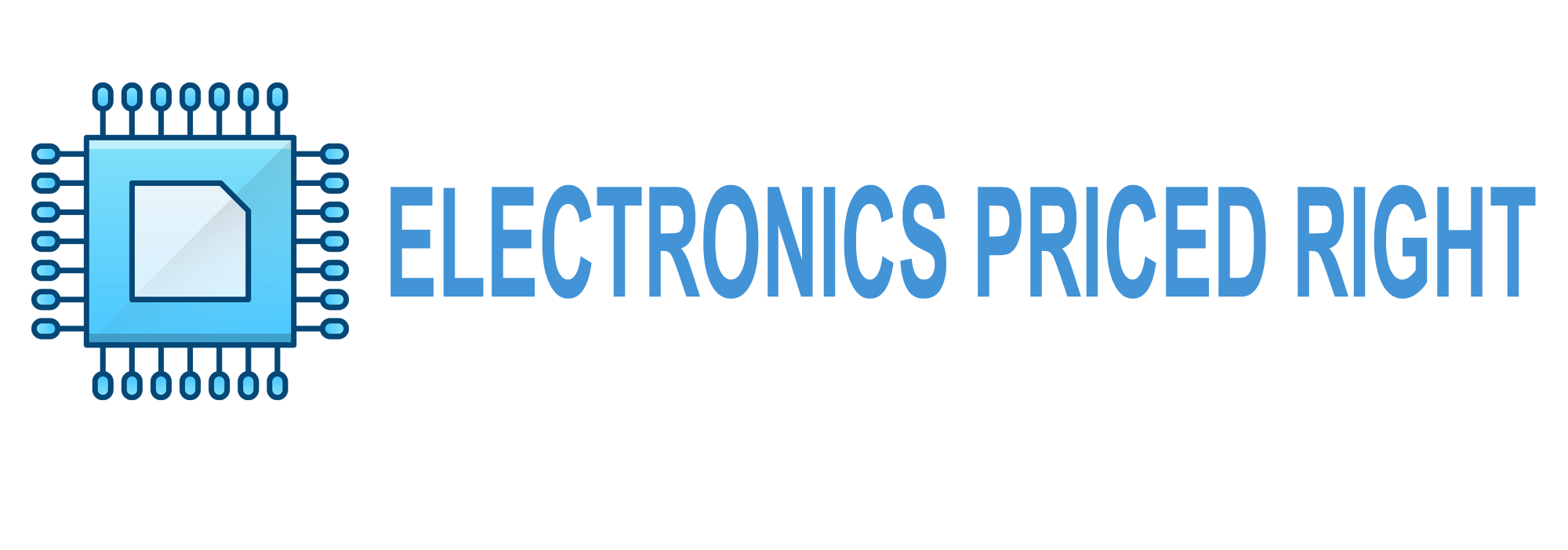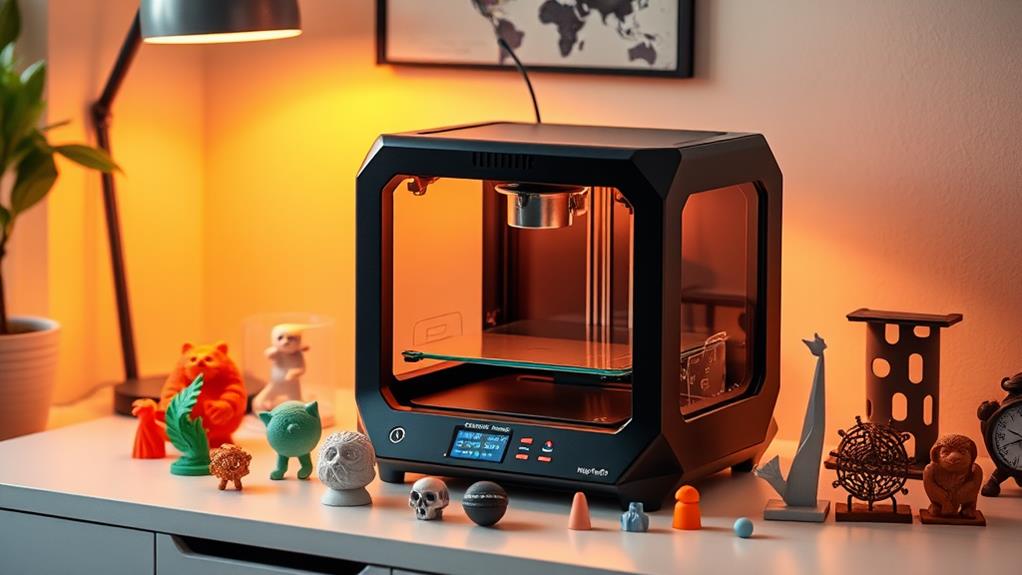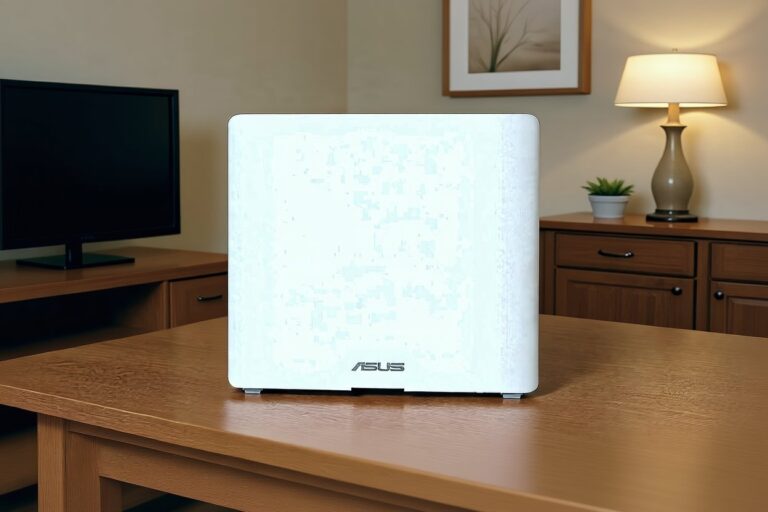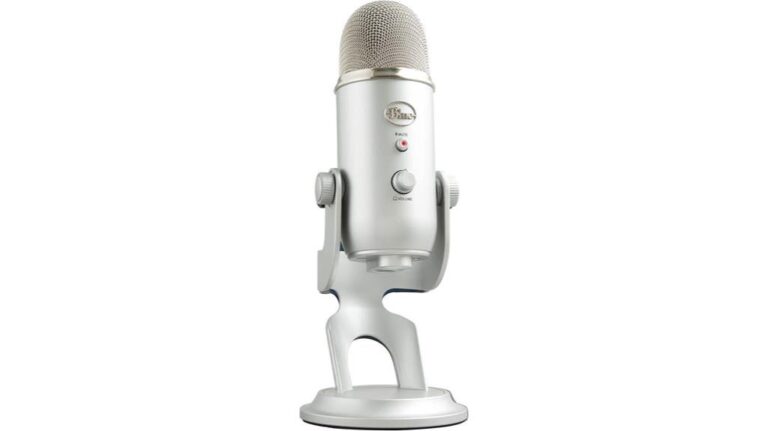Links below are affiliate links. We earn a commission on purchases at no extra cost to you. Although our opinions are based on curated research, we have not used these products. Article generated with AI.
The top 5 3D desktop printers offer a range of features for different needs. The TINA2 Mini is ideal for beginners with its plug-and-play design. FLASHFORGE Adventurer 5M boasts high-speed printing and auto-leveling.
ELEGOO Mars 5 uses 4K resin technology for ultra-fine detail. Entina Mini Tina 2 provides compact versatility with multiple material options. Creality Ender 3 offers a large build volume for DIY enthusiasts.
When choosing, consider print quality, build size, ease of use, speed, material compatibility, and price. Each printer has unique strengths, from user-friendly interfaces to advanced features like Wi-Fi connectivity. Further exploration will reveal which model best suits your specific requirements.
Main Points
- FLASHFORGE Adventurer 5M offers high-speed printing at 600mm/s and a generous build volume, making it versatile for various projects.
- ELEGOO Mars 5 Resin printer provides ultra-fine detail, with a 4K Mono LCD technology and a large build volume for resin-based projects.
- Creality Ender 3 combines a generous build size with advanced features like resume printing, suitable for DIY enthusiasts.
- TINA2 Mini and Entina Mini offer plug-and-play simplicity with auto-leveling, which is ideal for beginners despite limited build volumes.
- When choosing the best 3D desk printer, consider print quality, build volume, ease of use, printing speed, and material compatibility.
TINA2 Mini 3D Printer for Beginners (HEPHI3D FDM)
TINA2 Mini 3D Printer for Beginners (HEPHI3D FDM)
A compact, user-friendly 3D printer ideal for beginners. It features auto bed leveling, resume printing, and a high-precision dual-axis design. It’s fully assembled with an LCD display, sample filament, and pre-loaded models. It’s compatible with PLA, PLA Pro, and TPU. Includes a 30-day return policy and 12-month warranty.
Offering plug-and-play simplicity, the TINA2 Mini 3D Printer is ideal for beginners and young makers looking to plunge into 3D printing without the hassle of complex setups. This fully assembled printer features a user-friendly 2.4″ LCD display and comes with a sample PLA filament roll and pre-loaded model files. Its auto bed leveling guarantees precise printing, while the resume function safeguards against power outages.
You’ll appreciate the TINA2’s high-precision printing, thanks to its dual Z-axis and Y-axis rails. Compatible with PLA, PLA Pro, and TPU materials, it boasts a compact design with a removable magnetic build plate. While the 100x100x100 mm build volume may limit larger projects, the printer’s stability and quality make it suitable for home, school, or office use. Despite its strengths, competitors like the Bambu A1 Mini offer better performance at a similar price point, potentially making the TINA2 less competitive for advanced users.
Best For: Beginners, young makers, and those new to 3D printing who want a user-friendly, plug-and-play experience without complex setup or calibration.
Pros:
- Fully assembled with auto bed leveling for easy, precise printing
- Compact design with high-precision printing due to dual Z-axis and Y-axis rails
- Comes with sample PLA filament and pre-loaded model files for immediate use
Cons:
- Limited build volume of 100x100x100 mm restricts larger projects
- Less competitive compared to similarly priced models with better performance
- Occasional issues with off-center prints reported by some users
FLASHFORGE Adventurer 5M 3D Printer with Auto Leveling and High-Speed Printing
FLASHFORGE Adventurer 5M 3D Printer with Auto Leveling and High-Speed Printing
The Adventurer 5M Series revolutionizes 3D printing with one-click automatic bed leveling, 12X ultra-fast printing speeds, and smart features. It offers rapid nozzle changes, high-flow capability, and superior print quality across various materials. Real-time app monitoring ensures efficient, intelligent operation.
The FLASHFORGE Adventurer 5M 3D Printer is a speed demon, perfect for those who need rapid prototyping or high-volume production. With a maximum speed of 600mm/s and 20000mm/s² acceleration, it’s 12 times faster than typical 3D printers. You’ll appreciate its auto-leveling feature, which eliminates manual adjustments and guarantees consistent adhesion. The printer’s 220x220x220mm build volume is suitable for most projects, and its Core XY all-metal structure provides stability.
You can monitor and adjust settings remotely using the Flash Maker app, making it convenient for busy users. The printer’s versatility is enhanced by its compatibility with various nozzle sizes and materials. While some users have noted loud operation, the printer’s speed and accuracy make it a top choice, ranking #1 in 3D Printers on Amazon with a 4.1-star rating.
Best For: This 3D printer is best for professional users and enthusiasts who require high-speed printing for rapid prototyping or mass production, and value automated features for ease of use.
Pros:
- Ultra-fast printing speeds up to 600mm/s with high acceleration
- Fully automatic bed leveling for consistent first layers
- Remote monitoring and control via mobile app
Cons:
- The loud operation may be disruptive in quiet environments
- Initial lack of Wi-Fi support (though now updated)
- Some users report a need for improved software compatibility across operating systems
ELEGOO Mars 5 Resin 3D Printer with 4K Mono LCD
ELEGOO Mars 5 Resin 3D Printer with 4K Mono LCD
The Elegoo Mars 5 resin 3D printer offers effortless operation with one-click automatic leveling and self-checks. It features a 4K mono LCD for high-detail prints, smart residue detection, and resin shortage alerts. Advanced overheat protection and efficient cooling ensure safe, reliable performance for all skill levels.
For hobbyists and professionals seeking ultra-fine detail in their 3D prints, the ELEGOO Mars 5 Resin 3D Printer stands out with its 4K Mono LCD and advanced COB light source. This printer offers a generous build volume of 5.65 x 3.53 x 5.91 inches, making it suitable for many types of projects. You’ll appreciate its user-friendly features, including automatic leveling, a smart mechanical sensor for residue detection, and one-click self-checks before each print.
The Mars 5’s setup is effortless, thanks to its latch system and the larger touchscreen that’s compatible with gloves. Wi-Fi connectivity allows for easy file transfer from your slicer software. While the included ChituBoxPro slicer is functional, you may need to invest time in customizing settings. The printer excels in producing highly detailed prints, but ideal conditions are essential for bed adhesion, especially in colder environments.
Best For: Hobbyists and professionals seeking high-quality, detailed resin prints with minimal setup hassle and advanced features like automatic leveling and Wi-Fi connectivity.
Pros:
- Excellent print quality with 4K Mono LCD and advanced COB light source
- User-friendly features including automatic leveling and one-click self-checks
- Robust build quality with metal components and thoughtful design elements
Cons:
- Limited compatibility with slicers outside the ChituBox ecosystem
- Potential bed adhesion issues in cold environments
- Expensive replacement parts and potentially challenging FEP replacement
Entina Mini 3D Printer Tina 2 for Beginners
Entina Mini 3D Printer Tina 2 for Beginners
Compact and user-friendly, the Entina Mini 3D Printer Tina 2 offers a plug-and-play experience for novice makers. This pre-assembled unit features auto-leveling and a removable magnetic platform for easy print removal. Its high-precision capabilities ensure quality outputs for various 3D printing projects.
Compact and user-friendly, the Entina Mini 3D Printer Tina 2 is a perfect entry point for 3D printing novices. This fully assembled printer boasts a small footprint of 3.9×4.7×3.9 inches, making it ideal for home, classroom, or office use. With its auto-leveling system and magnetic build plate, you’ll find setup and model removal a breeze. The printer supports PLA, PLA Pro, and TPU materials, offering versatility for your projects.
You’ll appreciate the Tina 2’s dual Z-axis rails, which enhance stability and improve print quality. The 2.4-inch LCD screen allows for offline printing via MicroSD card, while the resume functionality lets you continue prints after power interruptions. However, be aware that its 100x120x100mm build volume limits larger projects. While some users find it slower than larger printers, many praise its high-precision results and child-friendly design.
Best For: Beginners, students, and hobbyists looking for an easy-to-use, compact 3D printer for small-scale projects and learning.
Pros:
- Fully assembled and auto-leveling for quick setup and ease of use
- Compact size ideal for small spaces and portability
- High-precision printing with dual Z-axis rails for improved stability
Cons:
- Limited build volume restricts larger projects
- Slower printing speed compared to larger printers
- Some users report issues when not using the manufacturer’s recommended software
Creality Ender 3 3D Printer
Creality Ender 3 3D Printer
Ender 3 offers resume printing after power outages, user-friendly assembly for beginners, and advanced extruder technology to reduce plugging. Features include a quick-heating bed, safety-protected power supply, and pre-delivery component testing. Voltage check recommended for optimal performance. Ideal for students and hobbyists.
Enthusiasts and beginners alike will find the Creality Ender 3 3D Printer an excellent entry point into the world of 3D printing. This model offers a generous printing size of 8.66 x 8.66 x 9.84 inches, allowing you to create a wide range of objects. You’ll appreciate the resume printing function, which lets you continue your project after unexpected power outages. The advanced extruder technology reduces the risk of plugging and guarantees smooth operation, while the safety-protected power supply heats up quickly.
Assembly takes about two hours, making it suitable for those who enjoy a DIY approach. Users report high-quality prints and praise the printer’s relatively quiet operation. While the included Cura software works well, you might consider upgrading to Simplify 3D for more advanced projects. Keep in mind that proper bed leveling and maintenance are vital for peak results. If you encounter issues, you’ll find a supportive community and helpful resources online to guide you through troubleshooting and potential upgrades.
Best For: Hobbyists and beginners looking for an affordable, user-friendly 3D printer with a good balance of features and print quality.
Pros:
- Large print volume for its price range
- Resume printing function for power interruptions
- Easy assembly and quiet operation
Cons:
- Manual bed leveling can be challenging for newcomers
- May require upgrades for optimal performance
- Mixed experiences with manufacturer support
Factors to Consider When Choosing 3D Desktop Printers
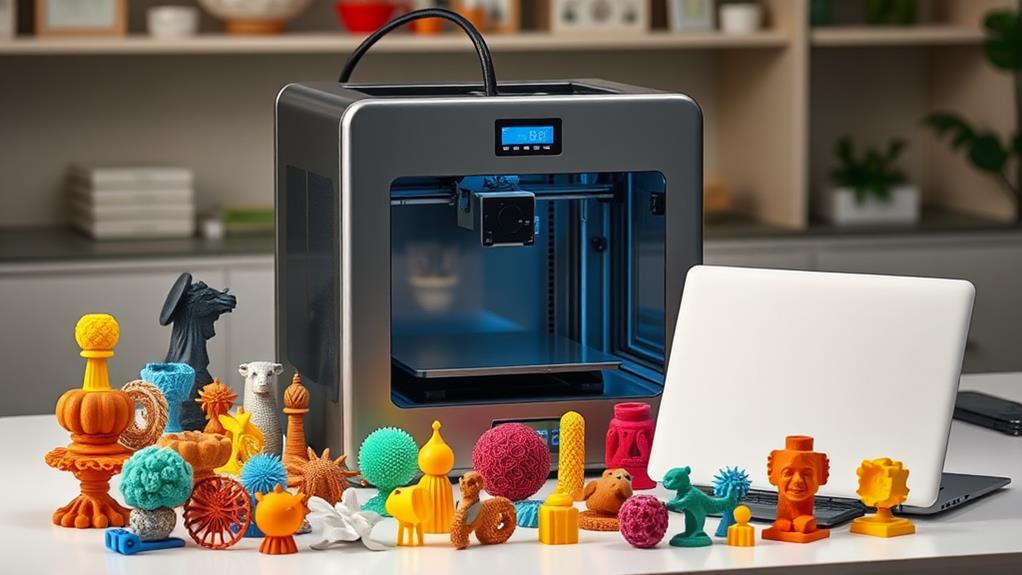
When choosing a 3D desk printer, you’ll need to weigh several key factors to guarantee you get the best machine for your needs. Consider the print quality and resolution, which determine the level of detail in your finished objects, as well as the build volume and size, which dictate the maximum dimensions of your prints. Other important aspects include ease of use, printing speed, and material compatibility, all of which can greatly impact your 3D printing experience and the range of projects you can undertake.
Print Quality and Resolution
Print quality stands as a cornerstone in the world of 3D desk printing. When selecting a printer, you’ll want to pay close attention to its resolution, typically measured in microns. Lower micron values indicate finer detail, with a 50-micron layer height producing higher quality prints than a 200-micron layer height.
The type of 3D printing technology also plays a vital role. SLA printers generally offer smoother surfaces and finer details than FDM printers, making them ideal for intricate projects.
Printers with dual Z-axis and Y-axis designs to enhance stability and precision. These features reduce vibrations during printing, resulting in higher-quality outputs. The materials you use will also impact print quality. PLA filament, for instance, offers good detail and is easy to work with, while PETG may require some adjustments for best results.
Finally, don’t overlook the importance of bed adhesion. Consistent adhesion to the print bed is essential for preventing warping and layer separation, which can negatively affect the overall resolution and appearance of your product.
Build Volume and Size
While print quality captures the fine details, build volume determines the scope of your 3D printing ambitions. When selecting a 3D desk printer, you’ll need account for the maximum size of objects you intend to create.
Build volume, measured in cubic millimeters or inches, defines the largest dimensions your printer can produce. Common sizes range from compact 100x100x100 mm for beginners to more spacious 220x220x220 mm or larger for advanced users.
A printer with a smaller build volume may suffice if you plan to work on small, intricate designs or simple projects. However, you’ll want to opt for a more generous build area for larger prototypes or multiple items in a single print. Entry-level printers often have limited build sizes, which may restrict your options, while advanced models offer greater flexibility for custom designs.
It’s essential to evaluate your intended use and account for future projects that might require more space. Remember, larger build volumes typically correspond to physically larger printers, so factor in the available space in your work area when making your decision.
Ease of Use
Frequently overlooked, ease of use can make or break your 3D printing experience. You’ll want models that come fully assembled and require minimal setup. This allows you to start printing right away without extensive calibration. Look for printers with automated features, such as auto bed leveling, that simplify the setup process and guarantee consistent print quality across projects.
A user-friendly interface is essential for beginners. An intuitive LCD can enhance your experience by making navigation and operation straightforward. You’ll also want to look for printers that offer resume functionality after power outages, providing peace of mind that your prints won’t be lost due to unexpected interruptions.
Compatibility with common materials like PLA is important, as is an easy filament-loading mechanism. These features can further simplify the printing process, especially if you’re new to 3D printing.
Prioritizing ease of use in your selection, you’ll guarantee a smoother, more enjoyable 3D printing experience. Remember, you will use a printer that’s simple to operate more frequently, helping you develop your skills and creativity in 3D printing.
Printing Speed
When you’re in the market for a 3D desktop printer, printing speed should be high on your list of considerations. Typically measured in millimeters per second (mm/s), faster printers can notably reduce your print times. High-end models can reach speeds of up to 600 mm/s, allowing for quicker project completion.
However, speed isn’t the only factor to take into account. Acceleration, measured in mm/s², affects how quickly your printer reaches its maximum speed. Higher acceleration values enable quicker starts and stops during printing.
It’s crucial to recognize that print quality can be influenced by speed. While faster printing reduces time, it may lead to less detailed results and an increased risk of print defects if not properly calibrated. Many printers offer adjustable speed settings, allowing you to balance speed and quality based on your specific project needs.
The complexity of your print design also impacts effective printing speed. Intricate models may require slower speeds to guarantee precision and detail are maintained throughout the process. When choosing a 3D desk printer, reflect on your typical projects and the desired balance between speed and quality.
Material Compatibility
Beyond speed, material compatibility is another significant factor in choosing a 3D desk printer. The range of materials your printer can handle directly impacts its versatility and the types of projects you can undertake.
Common materials include PLA, PLA Pro, TPU, PETG, and resin, each with unique properties and applications. FDM printers typically offer broader compatibility with thermoplastics, while resin printers specialize in photopolymer resins for high-detail prints.
When evaluating a printer’s material compatibility, consider your specific needs. If you’re creating flexible models, look for a printer that supports TPU. Some printers may require adjustments or modifications to work effectively with certain materials, such as altering temperature settings for filaments with higher melting points. It’s essential to guarantee your chosen printer is compatible with your desired materials to avoid issues like clogging, poor adhesion, and compromised print quality.
Selecting a printer that aligns with your material requirements, will enhance your overall user experience and expand your project possibilities. Material compatibility is vital to achieving satisfactory results and maximizing your 3D printing potential.
Price and Value
Price and value are essential when selecting the right 3D desk printer. When considering your purchase, you’ll find a wide range of options, from budget-friendly models starting around $200 to high-end professional printers exceeding $3,000. It’s vital to assess your budget constraints and long-term goals before deciding.
While entry-level printers may seem attractive due to their affordability, they often have limits with the build volume and print quality. These restrictions could hinder your ability to tackle more complex projects as your skills improve.
Instead, consider the printer’s long-term value, including print quality, ease of use, and potential for upgrades. Additionally, factor in the cost of materials and maintenance, as some printers require more expensive filaments or frequent replacement parts.
Don’t overlook the importance of warranty and customer support, as these can save you money and frustration in the long run. A printer with a longer warranty and responsive support team may offer better overall value, even if it comes at a higher initial cost.
Frequently Asked Questions
How Loud Are 3D Desktop Printers During Operation?
You’ll find that 3D desktop printers can be quite noisy during operation. They typically produce sound levels between 50 and 70 decibels, comparable to a normal conversation or a dishwasher. The noise comes from the printer’s moving parts, such as stepper motors and cooling fans. Some printers are louder than others, and factors like print speed and material type can affect noise levels. If you’re sensitive to sound, you might want to contemplate placing your printer in a separate room or using noise-reducing enclosures.
Can 3D Desktop Printers Be Used in Small Apartments or Shared Spaces?
You can use 3D desktop printers in small apartments or shared spaces, but there are considerations. Noise levels, ventilation, and space requirements are key factors. Many modern printers are designed to be compact and relatively quiet, making them suitable for smaller areas. However, you’ll need to manage fumes and guarantee proper airflow. It’s crucial to communicate with roommates or neighbors about your printing schedule and take steps to minimize disruptions, such as using enclosures or placing the printer on vibration-dampening surfaces.
What Safety Precautions Should Be Taken When Using 3D Desktop Printers?
When using 3D desktop printers, you’ll need to take several safety precautions. Guarantee proper ventilation to avoid inhaling fumes from melted plastics. Wear protective gloves and safety glasses to prevent burns or eye injuries. Keep the printer away from flammable materials and never leave it unattended while operating. Be cautious of moving parts that can pinch or crush. Regularly maintain your printer, checking for loose components or wear. Finally, familiarize yourself with the printer’s emergency stop function for quick shutdown if needed.
Are There Eco-Friendly Filament Options for 3D Desktop Printers?
Yes, there are eco-friendly filament options for 3D desktop printers. Several sustainable materials are available, including PLA (polylactic acid), which is derived from renewable resources like corn starch. Other options include wood-based filaments, recycled plastics, and biodegradable materials. These filaments often have a lower environmental impact than traditional plastics. However, it’s essential to recognize that while these materials are more eco-friendly, they may have different printing characteristics and post-processing requirements when compared to standard filaments.
How Often Do 3D Desktop Printers Require Maintenance and Part Replacements?
For peak performance, you’ll need to maintain your 3D desktop printer regularly. Typically, you should clean the print bed and nozzle after each print, and lubricate moving parts monthly. Part replacements vary based on usage, but you might need to change nozzles every 3-6 months and belts annually. Print heads and extruders may last 1-2 years. It’s essential to follow your printer’s manual, as maintenance needs can differ between models and manufacturers.
